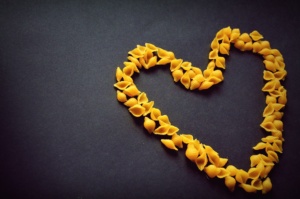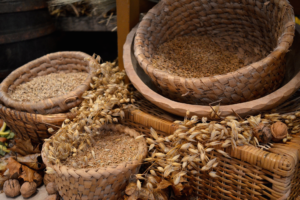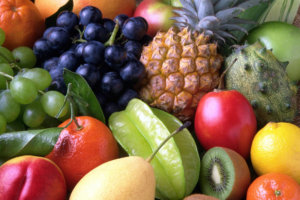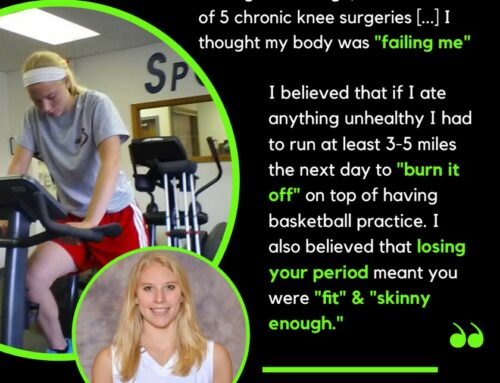 Unfortunately, carbohydrates do not have the best reputation, with some articles claiming that they cause excess weight gain, diabetes, and inflammation. If you look at the science though, when choosing nutrient-rich sources of carbohydrate- there simply isn’t a basis for these claims!
Unfortunately, carbohydrates do not have the best reputation, with some articles claiming that they cause excess weight gain, diabetes, and inflammation. If you look at the science though, when choosing nutrient-rich sources of carbohydrate- there simply isn’t a basis for these claims!
Our bodies need carbohydrate. In fact, the Institute of Medicine recommends that all children, teens, and adults get at least 130 grams per day. Of course athletes need much more. The American College of Sports Medicine, Academy of Nutrition and Dietetics, and Dietitians of Canada Joint Position Paper on Nutrition and Athletic Performance recommends that athletes, based on their level of exercise, consume 5 to 12 grams of carbohydrate per kilogram of body weight. For a 65 kg athlete (about 143 lb), this would equate to approximately 325 to 725 grams of carbohydrate per day.
Carbohydrates are particularly important for athletes because they are the body’s predominant source of fuel. They provide about 50% of the energy an athlete needs for moderate-intensity activity and up to 100% of the energy needed for high-intensity activity. That is a big responsibility!
Carbohydrates are also important because they spare another essential macronutrient, protein. The protein-sparing effect of carbohydrates is essential because it allows our body to use protein for its many essential roles in the body, such as building and repairing muscle tissue and synthesizing hormones, enzymes, and antibodies needed for the immune system, among other key roles.
All carbohydrates provide the body with needed energy. Carbohydrates from whole foods are especially helpful because they contain the added bonus of essential vitamins, minerals, and fiber. These “nutrient-rich” foods are the best carbohydrate choices for athletes. In general, there are five types of carbohydrates that provide the most fueling:
- WHOLE GRAINS: Foods containing whole grains are an excellent source of carbohydrate that are rich in B vitamins (thiamin, riboflavin, niacin, folate), iron, magnesium, and selenium. They also contain fiber, an indigestible component of plants, that helps us feel full, maintain healthy bowel function, and reduces our risk of heart disease, obesity, and type 2 diabetes.
You can get 15 grams of carbohydrates from the following whole grain foods: ⅓ cup of cooked brown rice, 1 slice of wheat bread, ⅓ cup of cooked whole grain pasta, 6 inch tortilla, ⅓ cup cooked quinoa, ½ cup of cooked oatmeal, ½ whole wheat English muffin, ¼ large whole wheat bagel, or ¾ cup dry, unsweetened cereal. 
- FRUITS: Fruits contain essential nutrients such as potassium, folate, vitamin C, and other antioxidants. These nutrients help regulate blood pressure, keep red blood cells healthy, and support growth, repair, and wound healing. Whole fruits, but not fruit juice, also contain fiber.
You can get 15 grams of carbohydrate from: 1 small apple or orange, ½ large banana, 2 small plums or tangerines, 1 kiwi, ½ mango or grapefruit, or ½ cup 100% fruit juice.

- VEGETABLES: Vegetables are also full of essential nutrients, such as potassium, folate, vitamin A, vitamin C, and fiber. Vegetables, like fruits, are rich in antioxidants, important in reducing inflammation and promoting recovery post-exercise. Eating vegetables may also reduce the risk for heart disease, certain types of cancers, obesity, and type 2 diabetes.
There are two types of vegetables: starchy and non-starchy vegetables. Starchy vegetables, including peas, corn, and potatoes, contain more carbohydrates than non-starchy vegetables.
You can get 15 grams of carbohydrates from the following starchy vegetables: ½ cup corn or peas, ¼ large baked potato, ½ cup diced sweet potato, ⅓ cup plantain or cassava.
You can get 5 grams of carbohydrates from the following non-starchy vegetables: ½ cup cooked broccoli or cauliflower, ½ cup cooked spinach or Swiss chard, 1 cup raw carrots, 1 cup raw cucumber, or ½ cup cooked zucchini or squash.

- BEANS & LEGUMES: These foods are interesting because they are rich in carbohydrate and also contain more protein than grains, fruit, and vegetables, making them a great combo food for athletes. In addition, they also provide fiber, B vitamins (niacin, thiamin, B6), iron, zinc, and magnesium.
You can get 15 grams of carbohydrates from: ½ cup cooked beans (kidney, garbanzo, navy, pinto, black, white, lima) or ½ cup cooked lentils (brown, yellow, green)

- MILK & YOGURT: Milk and yogurt also provide carbohydrate and protein. These dairy foods are rich in calcium, vitamin D, and potassium. They keep our bones and teeth strong. Dairy products are especially important during childhood and adolescence, when bone mass is being built.
The amino acid profile of milk and yogurt, which includes the essential branched chain amino acids (BCAAs), also optimize muscle recovery and muscle protein synthesis post-exercise.
You can get 12 grams of carbohydrates from: 1 cup of cow’s milk, ¾ cup plain yogurt. Fruit flavored yogurt, chocolate milk, or smoothies made with milk or yogurt and fruit, such as a banana, contain more carbohydrate, which helps with recovery after an intense and glycogen-depleting workout.
Enjoy building your diet around these fueling, nutrient-rich carbohydrates, which will set you up for success—with your health and performance goals!

References:
Academy of Nutrition and Dietetics, Dietitians of Canada, & the American College of Sports Medicine. (2016). Nutrition and athletic performance. Journal of the Academy of Nutrition and Dietetics, 116(3), 501-528.
Institute of Medicine. (2005). Dietary Reference Intakes for Energy, Carbohydrate, Fiber, Fat, Fatty Acids, Cholesterol, Protein, and Amino Acids. Washington, DC: The National Academies Press. doi: 10.17226/10490
Rosenbloom, C. & Coleman, E. (2012). Sports Nutrition: A Practice Manual for Professionals, 5th Edition. Academy of Nutrition and Dietetics.
U.S. Department of Health and Human Services & U.S. Department of Agriculture. (2015). 2015-2020 Dietary Guidelines for Americans, 8th Edition. Retrieved from: http://health.gov/dietaryguidelines/2015/guidelines/






